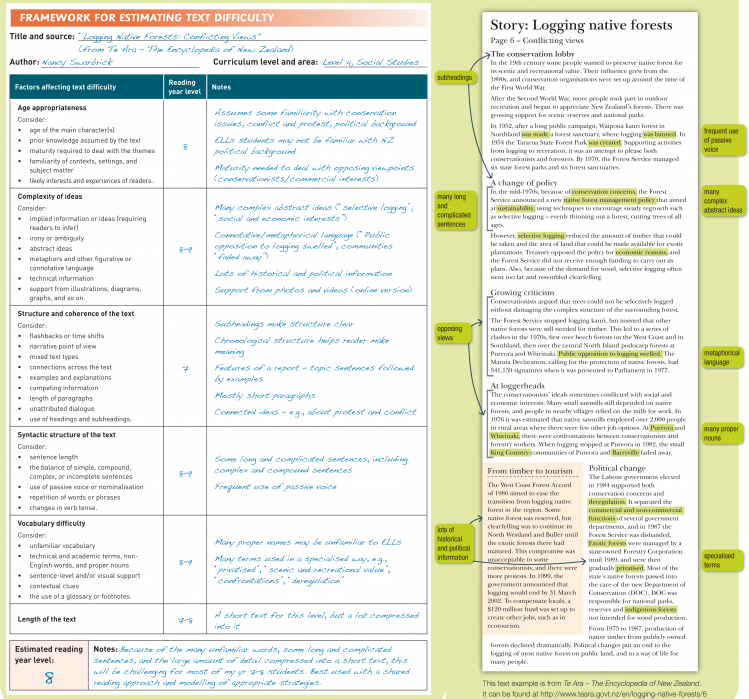Framework for estimating text difficulty
The framework (illustrated below) provides teachers with a simple, straightforward tool for estimating the reading year level of a text and for identifying the text characteristics that will support and challenge their students.
The framework can be used with texts from a wide range of sources, including magazine articles, newspaper articles, and extracts from chapter books, novels, reference books, and the Internet. Further information about the framework, including instructions for using it and a blank template, is included in Selecting Texts for Students in Years 4 to 8.
The teacher of a year 7–8 class was selecting texts for a level 4 social sciences study, Conservation – New Zealand Native Forests (conceptual strand: Place and Environment). His class would be required to read and synthesise information from a range of sources in order to evaluate how people’s decisions can protect or threaten native forests.
The teacher searched for a selection of texts in the instructional series at an appropriate level of difficulty for his students. Selected texts included:
- “Timber!”, School Journal, Level 3, November 2011
- “The Man in the Outside Office”, Connected 2 2010
- “Deer, Oh Deer”, School Journal, Part 4 Number 1, 2010
- The Wild Deer Debate (School Journal Story Library)
“The Man in the Outside Office” and “Timber!” (with a reading year level of 6) were likely to be easily manageable for most of the year 7 students in the class.
The teacher was aware that “Deer, Oh Deer”, a complex text with a substantial amount of technical vocabulary and many long and complex sentences, would be challenging for a number of students in the class. The Wild Deer Debate, a targeted School Journal Story Library text, provided these students with similar content at the same curriculum level but at a more manageable reading level.
The teacher support materials for “Timber!” and The Wild Deer Debate helped the teacher to identify the characteristics of these texts that might challenge particular learners. They also helped him to plan deliberate acts of teaching to support the learners to evaluate and use information from the texts.
The teacher also decided to use an extract (shown below) from Te Ara – The Encyclopedia of New Zealand to help support his students’ critical thinking skills and to provide background material for a class debate on the issue of felling native trees in private ownership. After using the framework from the guidelines to identify challenging text characteristics, the teacher decided that the text from Te Ara was likely to challenge all but his most able year 8 learners. He therefore decided to approach this text through shared reading, using an electronic whiteboard.
For the shared reading sessions, the teacher planned a range of scaffolding and specific teaching strategies to address the Te Ara text’s technical vocabulary, long and complex sentences, and large amount of historical detail.
The class followed up the shared reading by co-constructing a wallchart showing the timeline of the main events. They used this timeline for reference, along with the information they gained from the other texts, when they prepared their debate.
![]() NZC Update_table and story (PDF, 1 MB)
NZC Update_table and story (PDF, 1 MB)
The instructional series include Ready to Read, Junior Journal, School Journal, Connected, School Journal Story Library, and the electronic storybooks. Reading year levels are listed in their inside front covers and in the teacher support materials, which also include text characteristics. See Update 3 for further information on these series.


